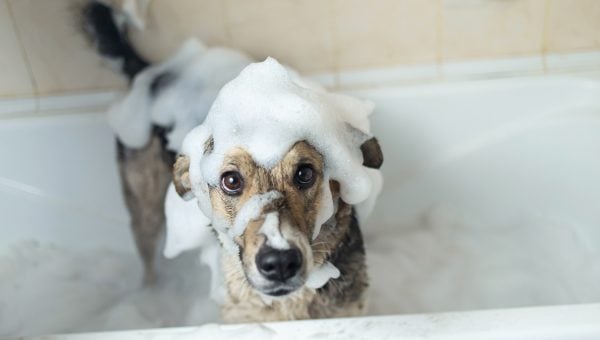- This post contains affiliate links. Read more here.
- Not a substitute for professional veterinary help.
The pet world is brimming with novel dog toys—a trend that can be equal parts exciting and confusing for today’s dog parents. Yes, the variety makes it easier to offer well-rounded enrichment for dogs. But with so many options available, how can pet parents reliably distinguish safe toys from hazardous ones? And what about popular conventional dog toys, like rope tugs and squeakers: can these carry risks as well?
Since play is important to our dogs’ health and happiness, we turn to the experts for answers. With their help, we break down what can make a toy potentially dangerous—and how dog parents can mitigate the risks to find the right toy for their pup.
Dog Toys with Dangerous Designs
What exactly makes a toy safe—or unsafe—for dogs? According to Max Randall, a UK-based dog trainer and the founder of MK9Plus Dog Training, there are a few parameters worth looking at.
If it’s not durable, it’s not safe
“One of the most important factors is the durability and strength of the toy,” says Randall. “Toys that are brittle or prone to breaking apart can pose a choking hazard or cause internal damage if ingested.”
Iram Sharma, DVM, a veterinarian and writer for PupVine, agrees, advising pet parents to avoid cheap plastic and flimsy rubber that’s liable to break. “When broken, these toys can have sharp cracks that cause serious injuries to the dog’s mouth, nose, paws, or teeth,” she explains.
Trust your gut—if a toy doesn’t feel sturdy in your hands, then it’s definitely not sturdy for your pup. Opt instead for toys made with tough materials, like nylon or heavy-duty rubber (like the KONG Classic, for example), that can withstand your dog’s chewing and playing habits.
“By being vigilant and choosing safe, high-quality toys, pet parents can help keep their dogs healthy and happy during playtime,” Randall emphasizes. “It’s also a good idea to monitor your dog’s play with toys, inspect the toys regularly for signs of wear and tear, and discard any that become damaged or worn out.”
Small pieces or attachments can pose a problem
Small pieces—like buttons, ribbons, strings, or tags—are another thing to watch. “Toys with small parts or loose components can be dangerous for dogs, as they can be easily torn apart and ingested, causing choking or intestinal blockages,” explains Randall.
Make sure your plush toys feature embroidery, not button eyes, before handing them over to your pup, and trim any tags that might give your dog easy purchase to tear a seam.
The wrong size might be dangerous
A toy’s size is important, too. “Toys that are too small can pose a choking hazard, especially for smaller dogs,” says Randall. “Toys that are too heavy or too hard can also be dangerous, as they can cause damage to teeth and gums.”
When choosing a new toy, make sure it’s small enough for your dog to carry effortlessly in their mouth but also big enough that it can’t be accidentally swallowed.

K_Thalhofer via iStock
Are Certain Types of Dog Toys Dangerous?
The good news is that when used properly and under human supervision, many popular toy styles are safe for most dogs. That being said, all toys come with some element of risk. Here’s what you should know to help minimize those risks.
Are rope toys dangerous for dogs?
The primary concern with rope toys is their tendency to fray over time. Once they unravel, individual strands can cause choking or GI obstructions. Rope toys can also harbor bacteria from your dog’s mouth.
To avoid these risks, spring for a heavy-duty rope made with materials built to last, like Mammoth Cotton-Blend Rope Toys. And make it a habit to wash and regularly inspect your rope toys for wear, discarding them once they’ve frayed.
Are squeaky toys dangerous for dogs?
By appealing to a dog’s inner hunter, squeaky toys offer a species-appropriate activity that dogs love. While squeaky toys are suitable for most dogs, there are some pups with overzealous prey drives that might run into trouble.
These hunty dogs will stop at nothing until they’ve extracted the squeaker and “killed” their prey. Not only does this create a mess (especially if there’s stuffing involved), but it can also be problematic if a dog accidentally swallows the squeaker.
For these types of dogs, look for toys made from different materials like rubber or nylon that don’t produce the same high-pitched squeaking sounds as traditional squeaky toys. Or opt for toys that have a different type of sound altogether, like a crinkling or rattling noise.
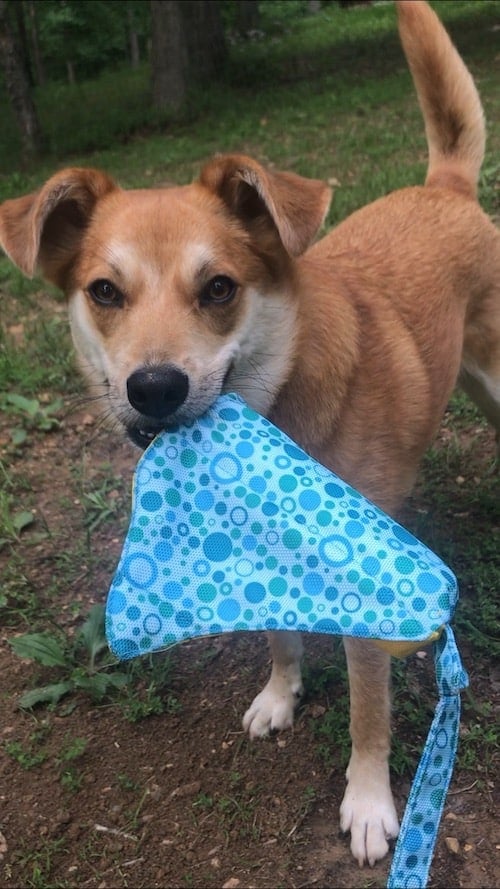
The Outward Hound Floatiez Stingray makes a fun giggling sound, offering a fun alternative to a squeaker for hunty dogs like Rover test pup Roo.
Are chew toys dangerous for dogs?
Dogs love to chew, and chew toys provide a safe and healthy outlet for this normal canine behavior—given the toy is the appropriate size and firmness for your pup’s chompers. If a chew toy is too hard, it could crack your dog’s teeth (which becomes especially dangerous with puppies and seniors). Or, if your dog breaks off pieces of the toy, they risk suffocation or injuring their mouth with the sharp edges.
For power chewers, choose a thicker, heavy-duty toy. Smaller jaws, on the other hand, will require a more delicate chew. The fingernail test is a good metric: press your nail into the chew toy’s material—if your nail doesn’t leave a mark, it’s probably too hard for your dog to seriously chew.
Is dog toy stuffing dangerous?
Yes, if ingested in significant quantities. Some dogs (like seniors and calm canines) can play gently with plush toys without any problems, but chew-happy dogs and teething puppies can tear a toy and eat the stuffing. “Toys with stuffing can be hazardous if dogs tear open the toy and ingest the stuffing, which can cause blockages or intestinal damage,” warns Randall.
If you have a master shredder, opt for soft toys without the stuffing for a safer alternative.
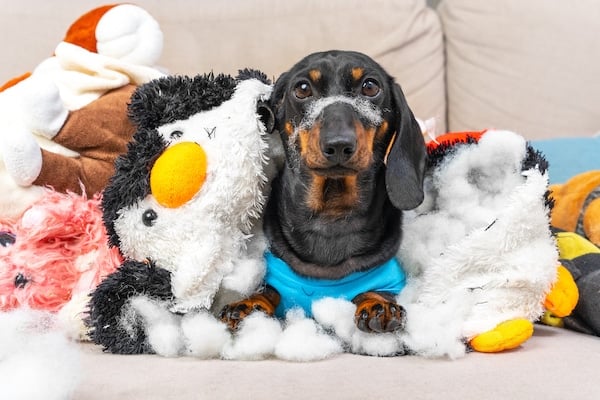
Ирина Мещерякова via iStock
Are dog toys made in China dangerous?
Toys made in China have been associated with safety concerns since they may contain harmful chemicals or materials toxic to dogs. “This is why it’s important to choose toys made by reputable manufacturers that use high-quality materials and follow safety standards,“ Randall points out.
While Dr. Iram Sharma admits that some products made in China use dangerous toxic materials, this doesn’t mean that all dog toys from China are dangerous.
“The fact that toys are made in China does not necessarily mean that they are low in quality,” she tells Rover. “There are many Chinese manufacturers that sell high-quality products on the U.S. market.”
Potential Toxic Materials in Dogs Toys
According to our experts, pet parents may encounter a few toxic materials in dog toys—particularly in cheap or fake toys that have become ubiquitous with online retailers. Here’s what to look for.
PVC and phthalates
PVC (aka vinyl) is a type of plastic that’s often used to make toys and other pet products. On the surface, PVC isn’t dangerous. However, it’s a really hard material, which is why manufacturers often add phthalates to vinyl dog toys and chews. “[PVC] may contain phthalates, which are chemicals that are used to soften plastic and make it more flexible,” Randall explains.
The more your dog plays and chews on vinyl, the more phthalates seep out. These toxins move freely and can be absorbed into your dog’s gums or skin. Additionally, PVC contains chlorine. As a dog chews a toy made of PVC, the chlorine is released over time.
Unfortunately, phthalates are associated with reproductive and developmental problems, so it’s especially important to avoid giving vinyl toys to growing puppies and kittens.
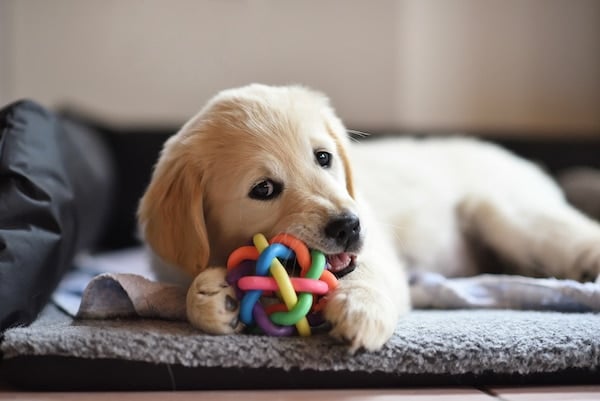
Photology1971 via iStock
Bisphenol A (BPA)
“BPA is another chemical that is commonly found in plastic products and has been linked to health problems like cancer and hormone disruption,” Randall tells us.
A 2017 in Science Direct also showed that BPA upsets the canine endocrine system and can cause disruptions to a dog’s metabolism.
Lead
Lead is another metal that shows up most often in a toy’s paint. “Although you won’t find lead in dog toys that are made under strict safety regulations, countries with less strict regulations will most likely include this toxic component in their products,” Dr. Sharma points out. “Lead can cause serious neurological consequences in dogs that are frequently exposed to it.”
Puppies and kittens are most susceptible to lead poisoning. But any animal in contact with lead can get poisoned, which can then damage multiple organs, including the nervous system and the gastrointestinal tract.
Chromium and cadmium
These two chemicals are found in the dye of certain types of plastic. Chromium in trace amounts is an essential dietary mineral. However, high levels of chromium can be toxic.
In a test conducted by a forensic toxicologist for ConsumerAffairs, dog and cat toys made in China and sold at Walmart showed elevated levels of chromium. The same toxicology testing also turned up high levels of cadmium, a cancer-causing metal that can interfere with a dog’s joints, heart, and lungs.
Formaldehyde
“Formaldehyde is a chemical that is banned in many countries,” Dr. Sharma reassures us. “Unfortunately, some manufacturers include this harmful ingredient in dog toys, and it causes skin irritation and respiratory problems,” she adds. Typically, this chemical will be found in the adhesive used to bond toy parts together.
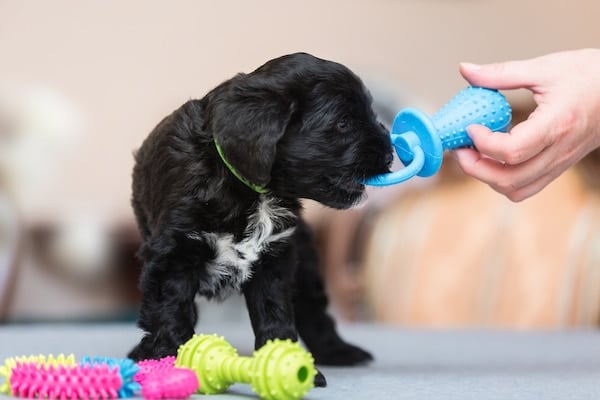
SStajic via iStock
How Can You Tell a Safe Dog Toy from a Dangerous One?
First, it’s important to understand that any dog toy can pose a risk—even if they appear perfectly safe.
“Any dog toy can potentially be dangerous, depending on the dog and how the toy is used,” Randall reiterates. “For example, a toy that is safe for a small dog may not be safe for a larger dog that chews more aggressively. Even playing fetch with a ball or stick can be dangerous if the dog is playing too vigorously or if the toy is thrown too forcefully.”
While it’s unrealistic to assume a toy has zero level of risk, becoming familiar with potential dangers is half the battle. Once you understand how your dog likes to play, you can choose toys that will be safest for their unique circumstances.
It’s also worth noting that certain pet companies have more stringent production protocols, safety practices, and a general commitment to quality. Descriptors like “natural” aren’t scientific or specific enough to tell you whether the product is safe, but there are still good clues as to a product’s quality.
“Look for products that are labeled as BPA-free, phthalate-free, lead-free, and made from non-toxic materials like natural rubber or organic cotton [which is regulated by third-party certification],” says Randall.
It’s also a good idea to check out company statements about production and quality control on labels and websites. When in doubt, calling or emailing a company is the most reliable method for finding out the latest on their materials.
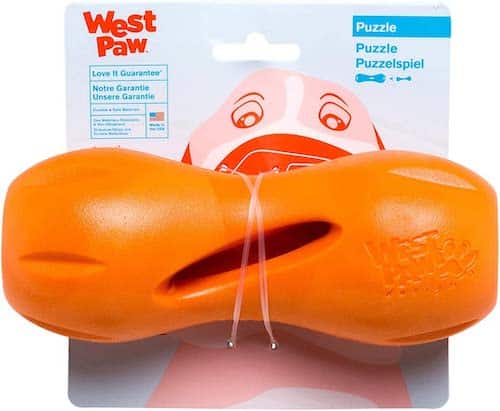
West Paw makes durable puzzle and chew toys, like the Qwizl, that are BPA-free, latex-free, and FDA-compliant.
A few trusted, Rover-approved pet brands include:
- KONG toys and chews—KONG is known for its classic rubber puzzle toy, which is also made in the U.S. from dog-safe materials.
- Chuckit! Dog Toys—According to Chewy, “Chuckit! Pet toys have been tested by an independent facility for lead, antimony, arsenic, barium, cadmium, chromium, mercury, and selenium and determined to be safe.”
- P.L.A.Y.—This company makes safe, eco-friendly toys that “meet the same strict quality standards for manufacturing children’s toys.”
- West Paw (certified B Corp)—This brand makes durable toys—like the popular Toppl and Qwizl—that are BPA-free, latex-free, and FDA-compliant.
“Ultimately, the best way to ensure that a dog toy is safe is to do your research and choose toys from reputable manufacturers that have a track record of producing safe, high-quality products,” recommends Randall. “Be sure to read labels and packaging carefully, and don’t hesitate to reach out to manufacturers or pet stores if you have any questions or concerns.”




